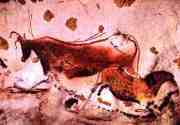
 |
ephemeris.com |
| NASA/JPL |
| Home | Ephemeris | Solar System | History | Space & Time | Software | Books | Links | Feedback |
| ephemeris - Latin, originally from the Greek "ephémeros, -on," daily. An almanac of the daily motions of the planets and stars. |
| ephemeris.com - A website devoted to information about time and motion in the universe. |
|
Prehistoric Ages.
Some bodies moved faster in the night sky than the surrounding stars. These were the planets visible to the unaided eye: Mercury, Venus, Mars, Jupiter, and Saturn. The word "planet" comes from the Greek word "planetes," which means "nomad" (wanderer, traveler). To the Babylonians and Sumerians before them, the planets were "stray sheep." The image at left shows our planet, the Earth, and the Moon viewed from Nasa's Mars Global Surveyor. The prehistoric ages date back to the Paleolithic (Early Stone) Age, which lasted from the first appearance of man to the end of the last Ice Age around 10,000 B.C.E. Neanderthal Man and Homo Erectus existed until about 30,000 B.C.E. The final period of the Paleolithic Age after this, during which only Homo Sapiens existed, is called the Upper Paleolithic or the Late Paleolithic Age. The last Ice Age began about 125,000 years ago. The Last Glacial Maximum, when the Earth's ice cover was greatest, occurred about 15,000 BCE. Between 15,000 BCE and 5,000 BCE, most of the world's glaciers melted. This created new habitable land, while the sea reclaimed former beaches and even valleys. Massive earthquakes and volcanic activity during this time caused great upheavals around the world. Myths of great floods occur in many of the world's cultures. Today, by examining sediment deposits and other clues, geologists have identified three times during the end of the Ice Age when massive ocean floods occurred in different parts of the world: approximately 13,000 BCE, 9,000 BCE, and 6,000 BCE. Cave paintings still exist in a few parts of the world dating back to the last Ice Age in the Upper Paleolithic Age, notably the cave paintings at Lascaux and surrounding areas. There was a transition from the Paleolithic Age to the Mesolithic (Middle Stone) Age around 11,000-9,000 B.C.E. During this time, man began to domesticate animals and live a more settled life. The Mesolithic Age transitioned to the Neolithic (New Stone) Age, which spanned approximately 8,000-5,500 B.C.E. During the Neolithic Age, man began to grow crops of plants. This meant an end to a nomadic, hunter-gatherer lifestyle. To live near crops, man had to build homes. These homes were often built together in vilages. There are traces of an ancient Mother Goddess of Anatolia, "Cybele," from Cayanu (now Eastern Turkey) dating to ca. 7,000 B.C.E. From Paleolithic to Neolithic times, man used stone tools. In following ages, man learned to work metal to make tools and weapons useful in agriculture, hunting, and war. The easiest metal to work was pliable copper. In the Calolithic (Copper Stone) Age, 5500-3000 B.C.E. man began to make tools from copper. The use of copper also encouraged trade for copper (and later other metals). This sent traders traveling far and wide. Expanding trade brought distant cultures in contact with each other throughout Europe, Asia Minor, and Africa. This trade also might have brought rise to early writing. Some of the earliest clay writings in Mesopotamia contain Sumerian loan records. Traders also found that another metal, tin, could be melted with copper to form bronze. This discovery ushered in the Bronze Age, lasting from about 3000-1200 B.C.E. Copper and tin are both soft metals, but the bronze alloy they form is much harder. Bronze therefore made far better tools and weapons than either tin or copper alone. Traders also came to sell valuable gold and silver during the Bronze Age. Cities in Europe and Asia Minor contained increasing wealth during this Age, and a growing number of fortified towns developed, with walls protecting them from attack. The Iron Age followed the Bronze Age, as man learned to work iron. By the time of the Iron Age, the extensive spread of trade had brought about the need for record keeping, which brought about formal writing. These written records preserved ancient histories for the ages, bringing an end to prehistoric times. Our ancient ancestors pondered the motions of the heavens. They wondered what the stars and planets could be. Some ancient societies discovered the cycles of motion of the Sun, Moon, planets, and stars. They made these observations for many generations. Some made astronomical observations so accurately that they were able to predict eclipses of the Sun and Moon. A total eclipse of the Sun is shown in a NASA photograph at the left, taken by the Apollo 12 crew during their return flight to Earth. To most ancients, eclipses were bad omens. Ancient astronomers recorded positions of the planets relative to the stars. They saw that the planets moved relative to the stars. The brightest stars were the easiest to spot. Stars of the first magnitude have been used for comparison since at least the days of ancient Babylon and probably long before then. Those stars are Aldebaran, Antares, Pollux, Regulus, and Spica. The Babylonians and others recorded two of these stars, Aldebaran (in Taurus) and Antares (in Scorpius), as exactly opposite each other and in the middle of their respective signs. They also recorded Spica (in Virgo) at or 1° distant from the middle of the Zodiac. Later, the Greek Astronomer Ptolemy (see below) combined his observations with those of his predecessor, Hipparchus, and defined the beginning of the Zodiac that became the standard among Western astronomers for almost 2000 years. They both drew upon observations recorded in Babylon, Egypt, and surrounding areas of the world. |
Lascaux.
 The Pyrenees Mountain region in the southwest of France has over 130 known
paleolithic limestone caves. Some time in the late 1930s near the
Pyrenees village of Montignac in the hills above the Lascaux Manor,
a great pine tree fell, revealing a hole where it once stood.
The Pyrenees Mountain region in the southwest of France has over 130 known
paleolithic limestone caves. Some time in the late 1930s near the
Pyrenees village of Montignac in the hills above the Lascaux Manor,
a great pine tree fell, revealing a hole where it once stood.
On 12 September 1940, four teenagers were hiking in this area and decided to explore this hole. They were Georges Agnel, Simon Coencas, Jacques Marsal, and Marcel Radiate. They enlarged the hole so they could descend into it, carrying a light. What they found was one of the greatest archaeological discoveries of the 20th century, now known as the Lascaux Caves.
They found paintings throughout these caves, largeley of animals. The main cave at Lascaux has over 1500 engravings and over 600 paintings. Marcel Radiate descended into another cavern 12 meters below the main on with a rope, enlarging that opening as well. There he found more paintings.
They showed the village what they had found the next day. Soon after, the greatest archaeologists of France began exploring the cave: Abbot Henri Breuil, Dr. Cheynier, Abbot J. and Abbot A Bouysonnie. They were followed later by D. Peyrony and Count Bégouën.
These caves were in use as early as 15,000 B.C.E. At the time, ice from the last Ice Age was receding.
The paintings even depict penguin-like animals called auks, pointing to the colder Mediterranean climate of the receding Ice Age. The painting shown here is from the Lascaux Caves, and was probably made close to 15,000 B.C.E. The line of dots under the horse are thought to represent the phases of the Moon. (In other words, this could be the world's oldest known ephemeris — a lunar ephemeris!) Later bone engravings found in Blanchard, France also show phases of the Moon as a winding string of dots.
Other engravings in the Lascaux Caves show other sequences of dots and possible ideograms. For example, there are circles consisting of 14 dots in a circle with another dot in the center (this might also have marked the Lunar Month), and of 11 dots in a circle with another dot in the center. Alexander Marshack, Professor of Paleolithic Archaeology ar Harvard University's Peabody Museum, was the first to draw the correlation between these ancient dot engravings acting as lunar calendars.
The Lascaux Cave paintings were made with the same pigments used to paint pottery in later civilizations. Animal fat was mixed with pigments to make the paint. The pigments were charcoal and lamp black (coal dust from lanterns) to form black; red iron oxide (hematite) to form red; and yellow iron oxide (limonite) to form yellow. Even these ancient cave dwellers knew that yellow iron oxide could be heated in a fire to turn first orange, then red. Thus they were able to form pigments of black, red, orange, and yellow found in their cave paintings. These pigments were made into a crayon stick for easy use.
Stonehenge.
 Probably the most famous ancient astronomical calculator is Stonehenge,
located on the Salisbury plain in the south of England. Three groups of people
built Stonehenge between 2000 B.C.E. and 1600 B.C.E. Earlier timber and
stone circles were built in the British Isles dating back to the late
Neolithic period in Britain, about 3000 B.C.E.
Probably the most famous ancient astronomical calculator is Stonehenge,
located on the Salisbury plain in the south of England. Three groups of people
built Stonehenge between 2000 B.C.E. and 1600 B.C.E. Earlier timber and
stone circles were built in the British Isles dating back to the late
Neolithic period in Britain, about 3000 B.C.E.
In modern times people knew of the Sun rising over the Heel Stone at Stonehenge to mark the Summer Solstice (the longest day of the year). However, nobody in modern times had an inkling of the full power of Stonehenge as an astronomical calculator until 1965, when Gerald S. Hawkins published his revolutionary book, Stonehenge Decoded. The book is now out of print, but if you're interested in the mathematics behind Stonehenge, Hawkins' book still has no equal. If you can find a used copy, it's well worth it. His book also captures the discovery process of a scientist testing his theories with a computer and finding that many proved true.
Stonehenge could calculate times in the solar year (positions of the Sun) and times in the lunar month (positions and phases of the Moon). With this detailed knowledge, ancient worshippers at Stonehenge could also predict eclipses on a 56-year cycle. This is one year short of three times the 19-year Metonic cycle, discovered by the Babylonians and again (or borrowed from the Babylonians) by the Greek astronomer Meton. Eclipses follow an 18.61-year cycle. Three times 18.61 is 55.83 years, or approximaely 56 years. Three black stones and three white stones were moved around these 56 Aubrey Holes. One of these stones on a certain Aubrey Hole would indicate an eclipse in that year.
British astronomer Fred Hoyle, Professor of Astronomy at Cambridge University, proposed another theory. He reasoned that the stones could be moved around the Aubrey Holes on a regular basis to track the Sun, Moon, and Moon's Node relative to each other. When the three coincided or lay opposite one another, an eclipse would occur.
| Home | Ephemeris | Solar System | History | Space & Time | Software | Books | Links | Feedback |
We're adding to this site constantly. If you have any comments or suggestions, please send email to mystars@ephemeris.com.
Copyright 2003-2004. All Rights Reserved.